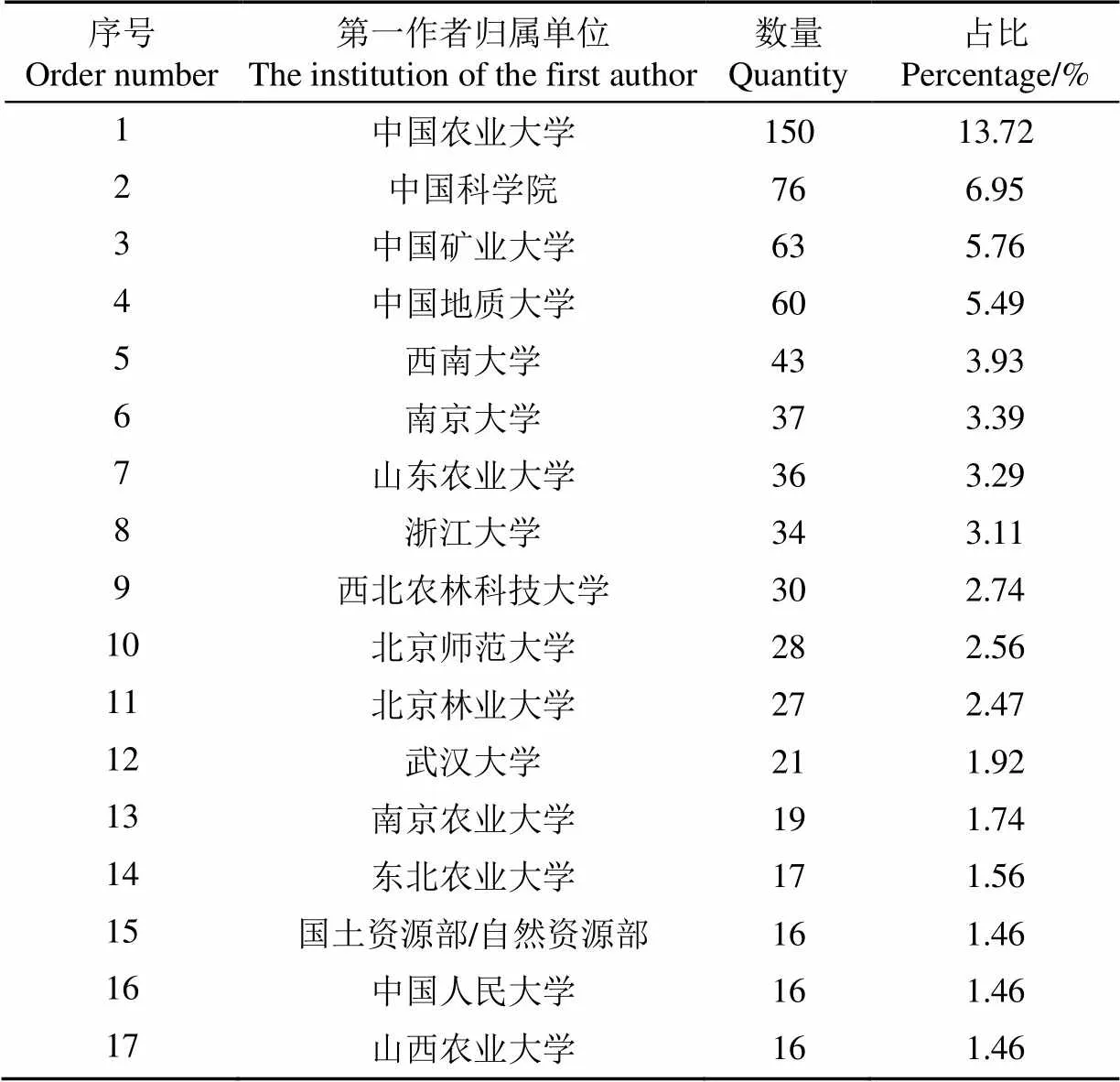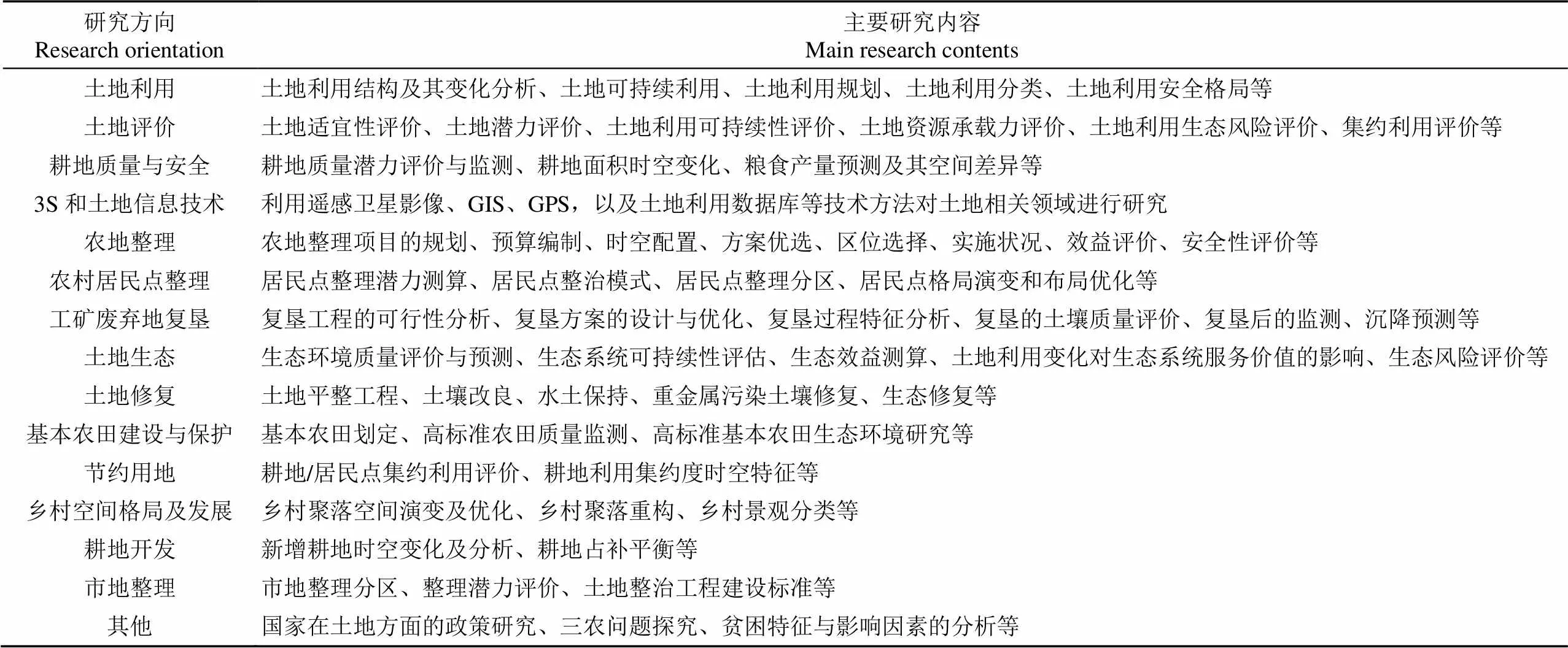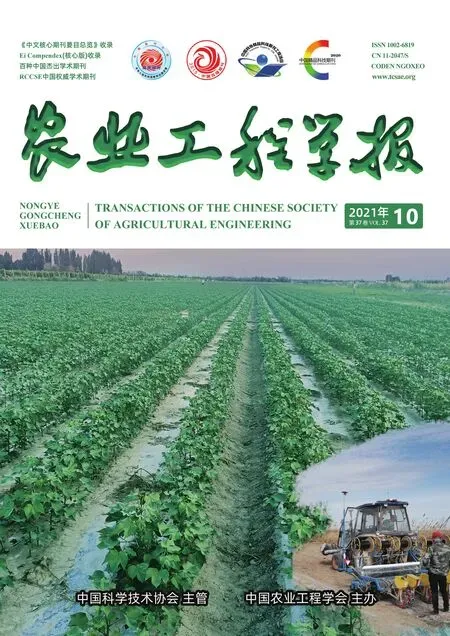中国土地整理工程发展回顾与展望——基于《农业工程学报》“土地整理工程”专栏2002—2020年刊载文献的计量学分析
王金满,郧文聚,白中科
中国土地整理工程发展回顾与展望——基于《农业工程学报》“土地整理工程”专栏2002—2020年刊载文献的计量学分析
王金满1,3,郧文聚2,白中科1,3
(1. 中国地质大学土地科学技术学院,北京 100083;2. 自然资源部国土整治中心,北京 100035;3. 自然资源部土地整治重点实验室,北京 100035)
土地整理工程是保障国家粮食安全与生态安全的重要手段。为了促进土地整理工程学术交流与科技创新,《农业工程学报》自2002年开始开设“土地整理工程”专栏,随着土地整理工程研究领域和内涵的不断拓展,2020年5月第9期开始,“土地整理工程”专栏更名为“土地保障与生态安全”。该文基于文献计量方法对《农业工程学报》“土地整理工程”专栏2002—2020年期间刊发的论文进行统计分析,并对不同研究方向的研究进展进行总结,提出未来土地资源保障与国土生态安全领域的研究重点,以期为中国的粮食安全与生态安全战略提供支撑。研究发现:土地整理工程主要研究方向包括土地利用、土地评价、农地整理、耕地质量与安全、3S和土地信息技术、工矿废弃地复垦、农村居民点整理、土地生态、土地修复、基本农田建设与保护、节约用地、乡村空间格局与发展、耕地开发、市地整理等方向;土地评价、农地整理和耕地质量与安全是学者们比较关注的热点,发文量分别占比10.52%、10.16%和8.51%;围绕土地评价、农地整理、耕地质量与安全、3S和土地信息技术和工矿废弃地复垦等方向,“土地整理工程专栏”形成了10个在全国处于领先研究地位的作者合作网络组团,以及5个关键词聚类;“土地整理工程专栏”刊发论文覆盖了土地整理工程的各个方向,近年来学者们更加关注生态化土地整治,基于景观生态学等理论来构建土地利用安全格局、分析土地整治的生态效应,同时关注土地整治单项工程的生态化设计与修复技术、农村居民点的格局演变与布局优化等内容。未来土地资源保障与国土生态安全研究将更注重“系统化、生态化、信息化和智能化”,研究区域生态系统保护修复的理论、方法和机理,实现“山-水-林-田-湖-草”的“整体保护、统一修复、综合治理”;借助基础信息大数据,开展自然资源一张图智能化管理研究,构建国土生态安全格局。
文献计量法;土地整理工程;土地资源;生态安全
0 引 言
土地整理工程是适应生产力的发展和经济建设的需要,对土地进行合理利用与改造治理的综合工程[1]。中国最早的土地整理可以追溯到3000年前的西周时期,但作为土地开发、利用、整治和保护的重要手段得以实施是在新中国成立之后。中国土地整理的探索、孕育、发展是人类利用自然、改造自然的必然措施,是经济社会发展到一定阶段,解决土地利用存在的问题及人地矛盾的必然选择。建国初期的土地整理还是一个探索过程,到了改革开放之后,土地整理工程开始从农业部门得到初步发展。1979年11月中国农业工程学会在杭州成立,土地利用(土地整理)工程专业委员会是最早成立的四个专业委员会之一。1981年由《农业工程》编辑部编辑出版的《农业工程土地利用工程专辑》首次详细阐述了土地利用(土地整理)工程的内涵与学科体系,1987年许燮漠和陈章琛共同主编出版了关于土地利用(土地整理)工程的第一本著作《土地利用工程》,这些标志着现代土地整理工程研究进入了一个新的里程[2]。
1998年,地质矿产部、国家土地管理局、国家海洋局和国家测绘局合并组建国土资源部,随之成立了负责土地整理工作的专门机构国土资源部土地整理中心,从此土地整理工程走上了蓬勃发展之路,关于土地整理工程的研究也随之增多。为了支撑土地整理工程事业、推动土地整理工程研究,自2002年开始,《农业工程学报》刊发了“土地整理工程”专题文章,与“农业水土工程”合在一个专栏;自2008年开始“土地整理工程”在《农业工程学报》开始独立开设专栏。粮食安全、生态安全都是未来中国国家战略关注点。2011年,绿色发展写入了国家“十二五”规划纲要,提出了“两屏三带”的生态安全战略格局。国家“十三五”规划建议提出,坚持最严格的耕地保护制度,坚守耕地红线,实施“藏粮于地、藏粮于技”战略,提高粮食产能,确保谷物基本自给、口粮绝对安全。同时,国务批准颁布了《全国土地整治规划》(2011—2015年)和《全国土地整治规划》(2016—2020年),提出以推进新农村建设和统筹城乡发展为根本要求,加快农村土地整治复垦,着力加强耕地质量建设,以基本农田整治为重点,在严格保护生态环境的前提下,建设旱涝保收高标准基本农田,积极开展城镇工矿建设用地整治。这些,都体现出了国家对粮食安全与生态安全的重视。习近平总书记《关于新时代中国特色社会主义生态文明建设——建设美丽中国》中也提出:“坚持人与自然和谐共生”、“绿水青山就是金山银山”、“山水林田湖草是一个生命共同体,统筹山水林田湖草系统治理”。从“十四五”开始,为了适应新时期国土综合整治与生态修复的要求,“土地整治规划”调整改为“国土空间生态修复规划”。由此可见,土地整理工程是保障国家粮食安全与生态安全的重要手段,土地整理工程也从最初的以补充耕地数量为主,向“数量、质量、生态”并重发展。“土地整理工程”这个名称已经不能全面涵盖当前国土整治与生态修复的内容,2020年5月第9期开始,“土地整理工程”专栏更名为“土地保障与生态安全”。
自《农业工程学报》“土地整理工程”专栏开办以来,学者们围绕土地利用、农用地整理、工矿废弃地复垦、耕地质量与安全等领域开展了大量研究,成为“土地整理工程”领域科研与学术交流的重要平台。文献计量分析方法是通过研究科学文献的外部特征,进而分析检索文献的分布结构、数量特征和变化规律,揭示某一研究领域的结构、特征和规律,具有显著的客观化、定量化、模型化的宏观研究优势[3]。因而,本文基于文献计量学方法对《农业工程学报》“土地整理工程”专栏2002—2020年开办期间刊发的论文进行统计分析,回顾总结不同时期土地整理工程的研究方向与研究进展,提出未来土地资源保障与国土生态安全领域的研究重点,以期为中国的粮食安全与生态安全战略提供支撑。
1 数据来源与研究方法
1.1 数据来源
本文以中国学术期刊(CNKI)数据库为检索平台,以《农业工程学报》“土地整理工程”专栏为检索项,检索2002—2019年、以及2020年前8期,刊登在《农业工程学报》“土地整理工程”专栏上的论文,共检索出1093条相关文献。依据关键词、题目、摘要这3项内容的先后顺序依次确定每条文献所属的研究方向,包括土地利用、土地评价、农用地整理、工矿废弃地复垦、农村居民点整理、耕地质量与安全、土地生态等14个研究方向。
1.2 研究方法
对收集到文献的发表时间、研究单位、作者合作关系、关键词词频以及文献的主要研究方向等进行描述性统计分析,分别得到《农业工程学报》“土地整理工程”专栏发表论文的时间分布、主要研究单位以及在该领域的主要研究方向等;其次,运用文献统计与分析软件VOSviewer,依据其共现和聚类原理显示主要研究者及其之间的合作关系,以及一定时期内的研究热点,对《农业工程学报》“土地整理工程”专栏研究论文进行多角度的综合分析。VOSviewer软件可通过“网络数据”(主要是文献知识单元)的关系构建和可视化分析,实现科学知识图谱的绘制,展现知识领域的结构、进化、合作等关系,其突出特点是图形展示能力强,适合大规模数据[4]。
2 土地整理工程专栏文献计量分析
2.1 年度发文量分析
对CNKI中《农业工程学报》“土地整理工程”专栏检索到的1 093篇文献进行年度发文量统计,可以发现其数量变化呈现上升趋势。“土地整理工程”专栏创建于2002年,在初期相关研究的文献数量存在一个加速上升时段(2002—2005),可见对土地整理的研究在逐渐被重视,有更多的科研工作者进行了相关研究。自2008年起土地整理工程开始独立开设专栏,其论文数量有较大增加,并基本稳定在每年70篇左右(图1)。
2.2 研究单位分析
全国许多科研单位、高校等在《农业工程学报》的“土地整理工程”专栏上发表了文章(表1)。其中,中国农业大学在相关领域的发表论文数量最多,截至2020年5月,该单位以第一作者身份累计发表期刊论文共150篇,占统计总篇数的13.72%。其次,中国科学院、中国矿业大学、中国地质大学和西南大学皆发表论文达40篇以上,分别占比6.95%、5.76%、5.49%和3.93%。
2.3 作者合作网络分析
依据VOSviewer软件生成的作者合作网络图谱(图 2),目前在《农业工程学报》“土地整理工程”专栏发表论文的主要研究者有张凤荣、郧文聚、孔祥斌、郝晋珉、白中科、胡振琪、孙丹峰、刘玉、许皞等。其中,发文次数最多的作者是张凤荣,发文数量高达40篇,与其合作密切的作者包括曲衍波、郭力娜和李灿等。同时,围绕郧文聚、白中科、胡振琪、许皞、郝晋珉、孔祥斌、赵庚星、魏朝富、刘玉、刘玉等作者,也形成了10个作者合作网络组团。

表1 《农业工程学报》土地整理工程专栏刊文的主要研究单位
2.4 关键词知识图谱分析
在VOSviewer软件中选取出现次数大于12的48个关键词进行共现和聚类分析,生成关键词共现网络图谱(图3)。观察图谱可以发现其中最大的关键节点是“土地利用”,且中心度最高,几乎与其他关键词都存在一定的关联性。除此之外,模型和遥感等关键词出现的频率也较高,且与其他关键词联系密切,说明《农业工程学报》“土地整理工程”专栏里的研究大多与“土地利用”主题相关,且多数借助于遥感手段和各类模型方法完成。
对提取出的关键词进行聚类分析,结果表明:类1主要包括关键词有土地复垦、土壤、评价、景观格局、煤矿等,该类别主要是对工矿废弃土地复垦以及复垦前后的景观格局、土壤等变化进行讨论;类2主要包括关键词有农村地区、农村居民点、整治、整理、分区、适宜性评价等,该类别主要讨论的是对农村地区的整治(整理)分区及其适应性评价;类3主要包括关键词有土地利用、模型、生态、耕地、驱动力、空间格局等,该类别主要讨论的是利用不同模型研究土地利用变化及其驱动因素分析;类4主要包括关键词有土地整治、农用地、规划、耕地质量、分等、监测等,该类别主要讨论的是农用地方面的整治项目以及对耕地质量的分等监测;类5主要包括关键词有遥感、地理信息系统、分类等,该类别主要讨论的是遥感和地理信息系统在土地分类方面的作用和贡献;类6主要包括关键词有土地整理、区域规划等,该类别主要讨论的是不同区域土地整理工程技术与模式。
2.5 研究方向分类分析
《农业工程学报》“土地整理工程”专栏的刊文可以按其研究的主题及主要内容分为土地利用、土地评价、农地整理、耕地质量与安全、3S和土地信息技术、工矿废弃地复垦、农村居民点整理、土地生态、土地修复、基本农田建设与保护、节约用地、乡村空间格局及发展、耕地开发、市地整理等14类(图4)。其中,土地利用方向的发文数量最多,共计299篇,占统计总篇数的27.36%。其次,发文量排名靠前的分别是土地评价、农地整理以及耕地质量与安全,分别占比10.52%、10.16%和8.51%。
当前,土地整理工程的目标和内涵等都发生了转变,转向了“国土整治与生态修复”,树立山水林田湖草是生命共同体理念,由单一生态要素修复转向多生态要素系统修复,实行山水林田湖草整体保护、系统修复、综合治理,因而“工矿废弃地复垦”和“土地修复”方向仍是未来需要强化和坚持的方向,同时应该关注生态保护修复的系统化研究;同时,国土整治与生态修复是实现乡村振兴的重要手段,自然资源部从2020年开始开展了全域土地综合整治工作,“农村居民点整理”和“乡村空间格局及发展”也是未来需要强化和坚持的方向。再者,当前的国土整治与生态修复方法由重工程建设转向保护优先、以自然恢复为主、辅助人工修复,但是当前相关的研究还不足,该方向亟需填补和加强。当前,大数据和人工智能是研究热点领域,未来国土整治与生态修复需要充分利用大数据、云计算、5G网络、人工智能、卫星遥感、北斗导航、地理信息及物联网等新一代信息技术,融合空天地立体动态监测网络,因而,需要重视“3S和土地信息技术”研究方向,提升国土整治与生态修复的信息化和智能化水平。
3 土地整理工程研究进展
对《农业工程学报》“土地整理工程”专栏检索到的1 093篇文献在14个研究的方向的主要研究内容进行梳理(表2),从表中可以看出学者们研究的主要内容与图3“土地整理工程”专栏高频关键词共现网络可视图反映的内容基本一致。
由于论文主要集中在土地利用、土地评价、农地整理、农村居民点整理和工矿废弃地复垦几个方向(图4),因而对这几个方向的主要研究进展进行重点分析。

表2 《农业工程学报》“土地整理工程”专栏主要研究内容
3.1 土地利用
土地利用领域的主要研究内容包含土地利用结构及其变化分析[5][1,2]、土地可持续利用[6]、土地利用规划[7]、土地利用分类[8]、土地利用生态安全格局[9]等。土地利用的研究范围广泛,研究方向繁多,但土地利用结构及其变化分析始终占据着主导地位。关于其研究的主要内容有土地利用驱动力分析和土地利用结构的模拟优化等[10],研究中期还增加了与地表温度和地形梯度等方面的影响研究[11]。在单地类的研究上,耕地变化及驱动力分析[12]则是一大研究热点。生态安全关系到人类的生存与发展,土地利用中的生态安全问题日渐凸显,近年来针对土地利用生态安全格局研究增多[13-14]。在土地利用变化的研究方法上,主要是应用3S和土地信息技术[15],以及CLUE-S模型、元胞自动机等[16]模拟优化模型。相关研究的开展,揭示了土地整理对土地利用变化及其生态环境的动态影响,为开展耕地保护和生态型土地整理提供理论依据和技术支撑。
3.2 土地评价
土地评价的研究主要包括土地适宜性评价[17]、土地整治潜力评价[18]、土地利用可持续性评价[19]、土地资源承载力评价[20]、土地利用生态风险评价[21]和集约利用评价[22]等方面。从2002年至今该专栏逐渐从自然评价向综合性评价转变,进行土地资源的经济、社会和生态效益的综合分析。土地评价中应用较为广泛的方法主要有因素法和修正法[23]、特尔斐法[24]、指数和法[25]、聚类分析法[26]、层次分析法[27]、模糊评价法及灰色关联度分析法[28],且随着计算机的成熟化,人工神经网络模型、热点分析法、期望最大化算法、深度置信网络[29]等新方法也逐渐被使用。目前关于土地评价研究的热点在于多角度综合评价土地资源配置和土地利用的合理性,从而达到数量结构和空间布局的优化。相关研究的开展,为开展土地整理潜力评价、综合效益评价和后评价等提供了方便可靠的方法支持,促进了土地整理评价工作的信息化发展。
3.3 农地整理
农地整理的研究内容主要包含农地整理项目的规划、预算编制、时空配置、方案优选、区位选择、实施状况、效益评价和安全性评价[30-33],其中早期主要是对农地整理项目的一般性研究,后期则更加注重生态环境的保护以及经济社会生态效益的综合。在研究方法上,初期主要有整理潜力系数法、景观指数法、模糊综合评判法、可拓评价法、层次分析法、集对分析理论和信息熵理论,随着数学理论的应用以及计算机的发展,出现了空间自相关分析法、Ward系统聚类法、多目标粒子群以及降维处理密度图法和聚类分析法等[34-36]。随着国家对生态文明建设的重视,低碳生态型农地整理理念得到体现,包括生态廊道和生态网络建设[37]、单项工程生态化设计[38]等。相关研究的开展,为农田整理项目选址、潜力测算、工程布局、生态化设计、效益测算等提供了支撑,促进了农田整理由注重增加耕地、提升耕地质量向“数量、质量和生态”并重的方向转变。
3.4 农村居民点整理
农村居民点整理的研究内容在2011年之前主要围绕居民点整理潜力展开,2012—2015年关于居民点整治模式的研究则较为集中。此外,农村居民点的格局演变和布局优化,以及居民点整理分区属于近些年来的研究热点[39-41]。可以看出,目前对农村居民点整理的研究重点正在逐渐转移到空间布局变化的研究上来。对此,运用的主要研究方法有复杂网络法、空间制图法、空间自相关法、指数评价法、最小阻力模型[42-44]等。这些相关研究,揭示了中国农村居民点时空演变规律,为农村居民点整理复垦模式选择和格局优化以及开展村庄规划等提供了支撑。
3.5 工矿废弃地复垦
工矿废弃地复垦主要是对复垦项目方面的研究,包括复垦工程的可行性分析、复垦方案的设计与优化、复垦过程特征分析、复垦的土壤质量评价、复垦后的监测和沉降预测等[45-47],后期关注以特定的复垦对象进行新技术的应用与新模型的构建、复垦土地的跟踪监测等[48-49]、以及复垦土地景观格局与生态效应[50-51],注重矿区生态系统保护修复。在方法和技术应用方面,早期多应用多因素综合评价法、指标分析和多目标规划法、模糊综合评价-灰色关联优势分析与指数和法等,后期主要为网格搜索随机森林算法、时序NDVI、DSR模型和最小数据集法等[52-53]。这些研究的开展,为进行工矿废弃地进行“地貌重塑-土壤重构-植被重建-景观重现-生物多样性重组与保护”一体化复垦提供了理论依据,为实现工矿区生态系统修复提供了保障和支撑。
综上可见,《农业工程学报》“土地整理工程”专栏刊发论文研究内容广泛,涵盖了土地整理工程的各个方向,成为中国土地整理工程学者主要的学术交流平台。这些成果及其应用,有效地支撑了中国土地整理工程事业的发展。
4 讨 论
该文基于《农业工程学报》“土地整理工程”专栏2002—2020年刊载文献采用文献计量学方法对中国土地整理工程研究方向与研究进展进行了分析,可反映近20年来中国土地整理工程发展总体趋势,但由于文献只限于《农业工程学报》“土地整理工程”专栏,肯定会存在一定的疏漏,以该时间段土地整理工程领域的全部文献为样本来进行分析,会更加全面系统地反映中国土地整理工程发展,下一步应拓展文献来源,深入总结不同时期土地整理工程的研究方向与研究进展,以为支撑粮食安全、生态安全等国家战略提供更加系统全面的科学依据。
5 结论与展望
本文基于文献计量的方法对《农业工程学报》“土地整理工程”专栏2002—2020年开办期间刊发的论文进行统计分析,并对不同研究方向的研究进展进行总结,通过研究发现:
1)土地整理工程主要研究的方向包括土地利用、土地评价、农地整理、耕地质量与安全、3S和土地信息技术、工矿废弃地复垦、农村居民点整理、土地生态、土地修复、基本农田建设与保护、节约用地、乡村空间格局与发展、耕地开发、市地整理等14个方向,其中土地利用、土地评价和农地整理方向研究的学者较多,发表论文数量较大。
2)依据VOSviewer软件生成的作者合作网络图谱,围绕土地评价、农地整理、耕地质量与安全、3S和土地信息技术和工矿废弃地复垦等方向,“土地整理工程”专栏形成了10个在全国处于领先研究地位的作者合作网络组团、5个关键词聚类,作者合作网络组团与关键词聚类在研究内容方面表现出了一致性。
3)“土地整理工程”专栏刊发论文覆盖了土地整理工程的各个方向,近年来学者们更加关注生态化土地整治,基于景观生态学等理论来构建土地利用安全格局、分析土地整治的生态效应,同时关注土地整治单项工程的生态化设计与修复技术、农村居民点的格局演变与布局优化等内容。
当前,国土综合整治与生态修复已成为保障土地资源与国土生态安全的重要手段。山水林田湖草是一个生命共同体,要统筹山水林田湖草系统治理,展望未来,应加强如下研究:
1)国土整治与生态修复的系统化研究。结合国家“山水林田湖草沙”一体化保护修复工程,以流域尺度开展研究,综合考虑生态系统退化状态,分析研究导致生态系统退化的主导驱动因子及其环境影响因素与影响作用机制;研究生态系统退化的阈值及其响应原理和机制。研究山、水、林、田、湖、草各生态修复因子的交互影响机理与作用机制,提出生态系统结构与功能提升的主要驱动机制。
2)国土整治与生态修复的生态化研究。结合《全国重要生态系统保护和修复重大工程总体规划(2021—2035年)》,针对不同区域生态系统退化问题,研究地貌重塑、土壤重构、植被重建、生物多样保育等低碳绿色整治修复新材料、新工艺与新方法,建立山水林田湖草沙整治修复的生态化技术标准体系。
3)国土整治与生态修复的信息化研究。针对生态系统受损问题,研究大尺度生态因子基础信息采集布设方案,研究大尺度三维地形地貌无人机低空摄影测量等快速精准获取方法,研究土壤数据无损探测获取技术,研究大尺度多源遥感数据融合的生态因子退化与修复监测方法,构建区域尺度生态因子基础信息平台,支撑国家生态保护修复工作。
4)国土整治与生态修复的智能化研究。利用物理工程、生物生态工程和大数据等模拟技术,对生态系统驱动退化与修复的原理进行大尺度的空间和时间模拟,对影响生态系统退化与修复的因子进行环境因素控制实验,摸索控制生态系统退化与修复的作用机理和措施,实现国土整治与生态修复的智能化管控。
[1] 许燮谟. 论土地利用工程[J]. 农业工程学报,1986,2(2):58-68.
[2] 许燮谟,陈章琛. 土地利用工程[M]. 北京:农业出版社,1987.
[3] 巩杰,燕玲玲,徐彩仙,等. 近30年来中美生态系统服务研究热点对比分析:基于文献计量研究[J]. 生态学报,2020,40(10):3537-3547.
Gong Jie, Yan Lingling, Xu Caixian, et al. A comparative review of research highlights on ecosystem services of China and USA in the latest 30 years[J]. Acta Ecologica Sinica, 2020, 40(10): 3537-3547. (in Chinese with English abstract)
[4] 赵海莉,张婧. 基于Citespace和Vosviewer的中国水旱灾害研究进展与热点分析[J]. 生态学报,2020,40(12):4219-4228.
Zhao Haili, Zhang Jing. The research progress and hotspots of flood and drought based on Citespace and Vosviewer[J]. Acta Ecologica Sinica, 2020, 40(12):4219-4228. (in Chinese with English abstract)
[5] 王盼盼,宋戈. 1979—2015年松嫩高平原土地利用格局变化及影响因子分析[J]. 农业工程学报,2018,34(2):256-264.
Wang Panpan, Song Ge. Land use pattern change and influential factors analysis of Songnen Plain in 1979-2015[J]. Transactions of the Chinese Society of Agricultural Engineering (Transactions of the CSAE), 2018, 34(2): 256-264. (in Chinese with English abstract)
[6] 赵兴国,潘玉君,丁生,等. 中国省域土地利用可持续性评价及时空格局特征[J]. 农业工程学报,2014,30(3):196-204.
Zhao Xingguo, Pan Yujun, Ding Sheng, et al. Evaluation of regional land use sustainability and its spatial-temporal pattern among provinces in China[J]. Transactions of the Chinese Society of Agricultural Engineering (Transactions of the CSAE), 2014, 30(3): 196-204. (in Chinese with English abstract)
[7] 郑新奇,赵璐,胡业翠,等. 土地利用总体规划指标时空分配[J]. 农业工程学报,2010,26(4):297-305.
Zheng Xinqi, Zhao Lu, Hu Yecui, et al. Spatio-temporal allocation of general land-use planning index[J]. Transactions of the Chinese Society of Agricultural Engineering (Transactions of the CSAE), 2010, 26(4): 297-305. (in Chinese with English abstract)
[8] 张合兵,李铭辉,张青磊. 基于多源数据的国土空间规划用地分类体系构建和土地类型识别[J]. 农业工程学报,2020,36(5):261-269.
Zhang Hebing, Li Minghui, Zhang Qinglei. Construction of land classification system and land type identification for territorial spatial planning based on multi-source data[J]. Transactions of the Chinese Society of Agricultural Engineering (Transactions of the CSAE), 2020, 36(5): 261-269. (in Chinese with English abstract)
[9] 陈文波,赵丽红,钱奇霞. 鄱阳湖区土地利用安全格局研究[J]. 农业工程学报,2008,24(7):86-90.
Chen Wenbo, Zhao Lihong, Qian Qixia. Establishment of land use security pattern in Poyang Lake Region[J]. Transactions of the Chinese Society of Agricultural Engineering (Transactions of the CSAE), 2008, 24(7): 86-90. (in Chinese with English abstract)
[10] 唐丽静,王冬艳,杨园园. 基于“多规合一”和生态足迹法的土地利用结构优化[J]. 农业工程学报,2019,35(1):243-251.
Tang Lijing, Wang Dongyan, Yang Yuanyuan. Optimization of land use structure based on “multiple planning integration” and ecological footprint[J]. Transactions of the Chinese Society of Agricultural Engineering (Transactions of the CSAE), 2019, 35(1): 243-251. (in Chinese with English abstract)
[11] 张静,任志远. 秦巴山区土地利用时空格局及地形梯度效应[J]. 农业工程学报,2016,32(14):250-257.
Zhang Jing, Ren Zhiyuan. Spatiotemporal pattern and terrain gradient effect of land use change in Qinling-Bashan mountains[J]. Transactions of the Chinese Society of Agricultural Engineering (Transactions of the CSAE), 2016, 32(14): 250-257. (in Chinese with English abstract)
[12] 郇红艳,谭清美,朱平. 城乡一体化进程中耕地利用变化的驱动因素及区域比较[J]. 农业工程学报,2013,29(21):201-213.
Huan Hongyan, Tan Qingmei, Zhu Ping. Driving factors of cultivated land use change in city and countryside integration process and region comparisons[J]. Transactions of the Chinese Society of Agricultural Engineering (Transactions of the CSAE), 2013, 29(21): 201-213. (in Chinese with English abstract)
[13] 何玲,贾启建,李超,等. 基于生态系统服务价值和生态安全格局的土地利用格局模拟[J]. 农业工程学报,2016,32(3):275-284.
He Ling, Jia Qijian, Li Chao, et al. Land use pattern simulation based on ecosystem service value and ecological security pattern[J]. Transactions of the Chinese Society of Agricultural Engineering (Transactions of the CSAE), 2016, 32(3): 275-284. (in Chinese with English abstract)
[14] 魏伟,石培基,周俊菊,等. 基于生态安全格局的干旱内陆河流域土地利用优化配置分区[J]. 农业工程学报,2016,32(18):9-18.
Wei Wei, Shi Peiji, Zhou Junju, et al. Configuration partition of land use optimization in arid inland river basin based on ecological security pattern[J]. Transactions of the Chinese Society of Agricultural Engineering (Transactions of the CSAE), 2016, 32(18): 9-18. (in Chinese with English abstract)
[15] 裴欢,孙天娇,王晓妍. 基于Landsat 8 OLI影像纹理特征的面向对象土地利用/覆盖分类[J]. 农业工程学报,2018,34(2):248-255.
Pei Huan, Sun Tianjiao, Wang Xiaoyan. Object-oriented land use/cover classification based on texture features of Landsat 8 OLI image[J]. Transactions of the Chinese Society of Agricultural Engineering (Transactions of the CSAE), 2018, 34(2): 248-255. (in Chinese with English abstract)
[16] 张晓娟,周启刚,王兆林,等. 基于MCE-CA-Markov的三峡库区土地利用演变模拟及预测[J]. 农业工程学报,2017,33(19):268-277.
Zhang Xiaojuan, Zhou Qigang, Wang Zhaolin, et al. Simulation and prediction of land use change in Three Gorges Reservoir Area based on MCE-CA-Markov[J]. Transactions of the Chinese Society of Agricultural Engineering (Transactions of the CSAE), 2017, 33(19): 268-277. (in Chinese with English abstract)
[17] 赵素霞,牛海鹏,张捍卫,等. 基于生态位模型的高标准基本农田建设适宜性评价[J]. 农业工程学报,2016,32(12):220-228.
Zhao Suxia, Niu Haipeng, Zhang Hanwei, et al. Suitability evaluation on high quality capital farmland consolidation based on niche-fitness model[J]. Transactions of the Chinese Society of Agricultural Engineering (Transactions of the CSAE), 2016, 32(12): 220-228. (in Chinese with English abstract)
[18] 杨红,张正峰. 河北省邢台市工业用地整治潜力评价方法[J]. 农业工程学报,2014,30(22):282-289.
Yang Hong, Zhang Zhengfeng. Evaluation method for consolidation potential of industrial lands in Xingtai city of Hebei province[J]. Transactions of the Chinese Society of Agricultural Engineering (Transactions of the CSAE), 2014, 30(22): 282-289. (in Chinese with English abstract)
[19] 于伯华,吕昌河. 基于DPSIR模型的农业土地资源持续利用评价[J]. 农业工程学报,2008,24(9):53-58.
Yu Bohua, Lyu Changhe. Assessment of sustainable use of agricultural land resources based on DPSIR Framework[J]. Transactions of the Chinese Society of Agricultural Engineering (Transactions of the CSAE), 2008, 24(9): 53-58. (in Chinese with English abstract)
[20] 姜秋香,付强,王子龙. 基于粒子群优化投影寻踪模型的区域土地资源承载力综合评价[J]. 农业工程学报,2011,27(11):319-324.
Jiang Qiuxiang, Fu Qiang, Wang Zilong. Comprehensive evaluation of regional land resources carrying capacity based on projection pursuit model optimized by particle swarm optimization[J]. Transactions of the Chinese Society of Agricultural Engineering (Transactions of the CSAE), 2011, 27(11): 319-324. (in Chinese with English abstract)
[21] 周启刚,张晓媛,王兆林. 基于正态云模型的三峡库区土地利用生态风险评价[J]. 农业工程学报,2014,30(23):289-297.
Zhou Qigang, Zhang Xiaoyuan, Wang Zhaolin. Land use ecological risk evaluation in Three Gorges Reservoir area based on normal cloud model[J]. Transactions of the Chinese Society of Agricultural Engineering (Transactions of the CSAE), 2014, 30(23): 289-297. (in Chinese with English abstract)
[22] 刘洁,王瑷玲,姜曙千,等. 胶州市胶北镇10个村庄土地集约利用水平评价[J]. 农业工程学报,2012,28(25):244-249.
Liu Jie, Wang Ailing, Jiang Shuqian, et al. Evaluation of land intensive use level in ten villages of Jiaobei town, Jiaozhou City[J]. Transactions of the Chinese Society of Agricultural Engineering (Transactions of the CSAE), 2012, 28(25): 244-249. (in Chinese with English abstract)
[23] 马仁会,李小波,李强,等. 农用地定级因素法与修正法比较分析[J]. 农业工程学报,2004,20(6):277-281.
Ma Renhui, Li Xiaobo, Li Qiang, et al. Comparison and analysis of factor method and modifying method for agricultural land gradation[J]. Transactions of the Chinese Society of Agricultural Engineering (Transactions of the CSAE), 2004, 20(6): 277-281. (in Chinese with English abstract)
[24] 袁磊,赵俊三,李红波,等. 云南山区宜耕未利用地开发适宜性评价与潜力分区[J]. 农业工程学报,2013,29(16):229-237.
Yuan Lei, Zhao Junsan, Li Hongbo, et al. Exploitation suitability evaluation and potential area zoning for arable unused land in mountainous areas of Yunnan Province[J]. Transactions of the Chinese Society of Agricultural Engineering (Transactions of the CSAE), 2013, 29(16): 229-237. (in Chinese with English abstract)
[25] 钱铭杰,吴静,袁春,等. 矿区废弃地复垦为农用地潜力评价方法的比较[J]. 农业工程学报,2014,30(6):195-204.
Qian Mingjie, Wu Jing, Yuan Chun, et al. Comparison for evaluate methods of potentiality for agricultural land reclamation from waste land in mining area[J]. Transactions of the Chinese Society of Agricultural Engineering (Transactions of the CSAE), 2014, 30(6): 195-204. (in Chinese with English abstract)
[26] 王瑞燕,赵庚星,李涛,等. GIS支持下的耕地地力等级评价[J]. 农业工程学报,2004,20(1):307-310.
Wang Ruiyan, Zhao Gengxing, Li Tao, et al. GIS supported quantitative evaluation of cultivated land fertility[J]. Transactions of the Chinese Society of Agricultural Engineering (Transactions of the CSAE), 2004, 20(1): 307-310. (in Chinese with English abstract)
[27] 高鹏,刘作新,邹桂霞. 丘陵半干旱区小流域土地资源定量化评价研究[J]. 农业工程学报,2003,19(6):298-301.
Gao Peng, Liu Zuoxin, Zou Guixia. Quantitative evaluation of land resources of small watershed in hilly semi-arid area of China[J]. Transactions of the Chinese Society of Agricultural Engineering (Transactions of the CSAE), 2003, 19(6): 298-301. (in Chinese with English abstract)
[28] 钱建平,周勇,郧文聚,等. 基于灰色系统理论的收益还原法在农用地估价中的应用[J]. 农业工程学报,2004,20(6):282-285.
Qian Jianping, Zhou Yong, Yun Wenju, et al. Application of income capitalization approach based on grey system theory in the evaluation of agricultrual land price[J]. Transactions of the Chinese Society of Agricultural Engineering (Transactions of the CSAE), 2004, 20(6): 282-285. (in Chinese with English abstract)
[29] 王华,罗平,赵志刚,等. 基于深度置信网络的农用地基准地价评估模型[J]. 农业工程学报,2018,34(21):263-271.
Wang Hua, Luo Ping, Zhao Zhigang, et al. Establishment of agricultural land appraisal model based on deep belief network[J]. Transactions of the Chinese Society of Agricultural Engineering (Transactions of the CSAE), 2018, 34(21): 263-271. (in Chinese with English abstract)
[30] 叶艳妹,吴次芳,刘可清,等. 可持续农地整理项目规划方法研究[J]. 农业工程学报,2002,18(6):186-189.
Ye Yanmei, Wu Cifang, Liu Keqing, et al. Theory and methods of the planning of sustainable agricultural land consolidation project[J]. Transactions of the Chinese Society of Agricultural Engineering (Transactions of the CSAE), 2002, 18(6): 186-189. (in Chinese with English abstract)
[31] 王瑷玲,赵庚星,袁祥明. 基于提高农业综合生产力的区域土地整理时空配置研究[J]. 农业工程学报,2007,23(8):90-94.
Wang Ailing, Zhao Gengxing, Yuan Xiangming. Spatio-temporal disposition of regional land consolidation aiming at increasing agricultural integrative productivity[J]. Transactions of the Chinese Society of Agricultural Engineering (Transactions of the CSAE), 2007, 23(8): 90-94. (in Chinese with English abstract)
[32] 郭力娜,张凤荣,曲衍波,等. 基于分等因素组合的农用地整理类型分区[J]. 农业工程学报,2010,26(9):308-314.
Guo Lina, Zhang Fengrong, Qu Yanbo, et al. Farmland consolidation type zoning based on combination of grading factors[J]. Transactions of the Chinese Society of Agricultural Engineering (Transactions of the CSAE), 2010, 26(9): 308-314. (in Chinese with English abstract)
[33] 薛永森,郧文聚,张凤荣. 四川震区土地整理安全性评价及措施[J]. 农业工程学报,2010,26(5):288-294.
Xue Yongsen, Yun Wenju, Zhang Fengrong. Security evaluation and measures of land arrangements in Sichuan seismic region[J]. Transactions of the Chinese Society of Agricultural Engineering (Transactions of the CSAE), 2010, 26(5): 288-294. (in Chinese with English abstract)
[34] 关涛,余万军,慎勇扬,等. 基于可拓评价方法的土地开发整理项目立项决策研究[J]. 农业工程学报,2005,21(1):71-75.
Guan Tao, Yu Wanjun, Shen Yongyang, et al. Decision-making of land development and consolidation project based on extension evaluation method[J]. Transactions of the Chinese Society of Agricultural Engineering (Transactions of the CSAE), 2005, 21(1): 71-75. (in Chinese with English abstract)
[35] 王华,朱付保. 基于多目标粒子群的土地整理项目选址模型[J]. 农业工程学报,2015,31(14):255-263.
Wang Hua, Zhu Fubao. Site selection model of land consolidation projects based on multi-objective optimization PSO[J]. Transactions of the Chinese Society of Agricultural Engineering (Transactions of the CSAE), 2015, 31(14): 255-263. (in Chinese with English abstract)
[36] 朱嘉伟,周琳琳,谢晓彤,等. 基于降维处理密度图聚类解析的农田整治分区[J]. 农业工程学报,2018,34(9):258-266.
Zhu Jiawei, Zhou Linlin, Xie Xiaotong, et al. Farmland consolidation partitioning by clustering analysis of density graph based on dimension reduction processing[J]. Transactions of the Chinese Society of Agricultural Engineering (Transactions of the CSAE), 2018, 34(9): 258-266. (in Chinese with English abstract)
[37] 黄雪飞,吴次芳,游和远,等. 基于 MCR 模型的水网平原区乡村景观生态廊道构建[J]. 农业工程学报,2019,35(10):243-251.
Huang Xuefei, Wu Cifang, You Heyuan, et al. Construction of rural landscape ecological corridor in water network plain area based on MCR Model[J]. Transactions of the Chinese Society of Agricultural Engineering (Transactions of the CSAE), 2019, 35(10): 243-251. (in Chinese with English abstract)
[38] 刘文平,宇振荣,郧文聚,等. 土地整治过程中农田防护林的生态景观设计[J]. 农业工程学报,2012,28(18):233-240.
Liu Wenping, Yu Zhenrong, Yun Wenju, et al. Ecological and landscape design of farmland shelterbelt in land consolidation[J]. Transactions of the Chinese Society of Agricultural Engineering (Transactions of the CSAE), 2012, 28(18): 233-240. (in Chinese with English abstract)
[39] 姜广辉,何新,马雯秋,等. 基于空间自相关的农村居民点空间格局演变及其分区[J]. 农业工程学报,2015,31(13):265-273.
Jiang Guanghui, He Xin, Ma Wenqiu, et al. Rural settlements spatial pattern evolution and zoning district based on spatial autocorrelation[J]. Transactions of the Chinese Society of Agricultural Engineering (Transactions of the CSAE), 2015, 31(13): 265-273. (in Chinese with English abstract)
[40] 王楠,郝晋珉,李牧,等. 生计转型背景下河北省农村宅基地整理分区与潜力研究[J]. 农业工程学报,2019,35(9):255-264.
Wang Nan, Hao Jinmin, Li Mu, et al. Zoning and potential of rural housing land consolidation in Hebei Province under background of livelihoods transformation[J]. Transactions of the Chinese Society of Agricultural Engineering (Transactions of the CSAE), 2019, 35(9): 255-264. (in Chinese with English abstract)
[41] 郑红玉,卓跃飞,吴次芳,等. 基于减量化目标的农村宅基地整理分区及模式优选[J]. 农业工程学报,2017,33(12):270-277.
Zheng Hongyu, Zhuo Yuefei, Wu Cifang, et al. Zoning and mode selection of rural residential land consolidation based on construction land reduction[J]. Transactions of the Chinese Society of Agricultural Engineering (Transactions of the CSAE), 2017, 33(12): 270-277. (in Chinese with English abstract)
[42] 冯应斌,杨庆媛. 1980-2012年村域居民点演变特征及其驱动力分析[J]. 农业工程学报,2016,32(5):280-288.
Feng Yingbin, Yang Qingyuan. Evolution characteristics and its driving force of rural residential land at village level during 1980-2012[J]. Transactions of the Chinese Society of Agricultural Engineering (Transactions of the CSAE), 2016, 32(5): 280-288. (in Chinese with English abstract)
[43] 周宁,郝晋珉,孟鹏,等. 黄淮海平原县域农村居民点布局优化及其整治策略[J]. 农业工程学报,2015,31(7):256-263.
Zhou Ning, Hao Jinmin, Meng Peng, et al. Layout optimization for county rural residents in Huang-Huai-Hai plain area and its remediation strategies[J]. Transactions of the Chinese Society of Agricultural Engineering (Transactions of the CSAE), 2015, 31(7): 256-263. (in Chinese with English abstract)
[44] 罗志军,赵越,李雅婷,等. 基于空间组合特征的农村居民点布局优化研究[J]. 农业工程学报,2019,35(4):265-272.
Luo Zhijun, Zhao Yue, Li Yating, et al. Research on rural residential area layout optimization based on spatial combination characteristics[J]. Transactions of the Chinese Society of Agricultural Engineering (Transactions of the CSAE), 2019, 35(4): 265-272. (in Chinese with English abstract)
[45] 胡振琪,赵艳玲,赵姗,等. 矿区土地复垦工程可垦性分析[J]. 农业工程学报,2004,20(4):264-267.
Hu Zhenqi, Zhao Yanling, Zhao Shan, et al. Analysis of reclamation feasibility in land reclamation planning[J]. Transactions of the Chinese Society of Agricultural Engineering (Transactions of the CSAE), 2004, 20(4): 264-267. (in Chinese with English abstract)
[46] 孙海运,李新举,胡振琪,等. 马家塔露天矿区复垦土壤质量变化[J]. 农业工程学报,2008,24(12):205-209.
Sun Haiyun, Li Xinju, Hu Zhenqi, et al. Variance of reclamation soil quality in Majiata opencast mine region[J]. Transactions of the Chinese Society of Agricultural Engineering (Transactions of the CSAE), 2008, 24(12): 205-209. (in Chinese with English abstract)
[47] 闫伟涛,陈俊杰,柴华彬,等. 矿区高强度开采地表损坏动态预测模型[J]. 农业工程学报,2019,35(19):267-273.
Yan Weitao, Chen Junjie, Chai Huabin, et al. Ground surface dynamic damage prediction model with high-strength mining in mining area[J]. Transactions of the Chinese Society of Agricultural Engineering (Transactions of the CSAE), 2019, 35(19): 267-273. (in Chinese with English abstract)
[48] 王金满,杨睿璇,白中科. 草原区露天煤矿排土场复垦土壤质量演替规律与模型[J]. 农业工程学报,2012,28(14):229-235.
Wang Jinman, Yang Ruixuan, Bai Zhongke. Succession law and model of reclaimed soil quality of opencast coal mine dump in grassland[J]. Transactions of the Chinese Society of Agricultural Engineering (Transactions of the CSAE), 2012, 28(14): 229-235. (in Chinese with English abstract)
[49] 周妍,罗明,周旭,等. 工矿废弃地复垦土地跟踪监测方案制定方法与实证研究[J]. 农业工程学报,2017,33(12):240-248.
Zhou Yan, Luo Ming, Zhou Xu, et al. Making method of tracking monitoring scheme for abandoned industrial and mining land reclamation and its empirical research[J]. Transactions of the Chinese Society of Agricultural Engineering (Transactions of the CSAE), 2017, 33(12): 240-248. (in Chinese with English abstract)
[50] 徐嘉兴,李钢,陈国良,等. 土地复垦矿区的景观生态质量变化[J]. 农业工程学报,2013,29(1):232-239.
Xu Jiaxing, Li Gang, Chen Guoliang, et al. Changes of landscape ecological quality for land reclamation in mining area[J]. Transactions of the Chinese Society of Agricultural Engineering (Transactions of the CSAE), 2013, 29(1): 232-239. (in Chinese with English abstract)
[51] 李保杰,顾和和,纪亚洲. 矿区土地复垦景观格局变化和生态效应[J]. 农业工程学报,2012,28(3):251-256.
Li Baojie, Gu Hehe, Ji Yazhou. Evaluation of landscape pattern changes and ecological effects in land reclamation project of mining area[J]. Transactions of the Chinese Society of Agricultural Engineering (Transactions of the CSAE), 2012, 28(3): 251-256. (in Chinese with English abstract)
[52] 陈英义,李道亮. 基于Web的煤矿废弃地土地复垦决策支持系统设计与实现[J]. 农业工程学报,2008,24(4):107-112.
Chen Yingyi, Li Daoliang. Design and implementation of web-based decision support system for land reclamation in abandoned coal mine land[J]. Transactions of the Chinese Society of Agricultural Engineering (Transactions of the CSAE), 2008, 24(4): 107-112. (in Chinese with English abstract)
[53] 陈元鹏,罗明,彭军还,等. 基于网格搜索随机森林算法的工矿复垦区土地利用分类[J]. 农业工程学报,2017,33(14):250-257.
Chen Yuanpeng, Luo Ming, Peng Junhuan, et al. Classification of land use in industrial and mining reclamation area based grid-search and random forest classifier[J]. Transactions of the Chinese Society of Agricultural Engineering (Transactions of the CSAE), 2017, 33(14): 250-257. (in Chinese with English abstract)
Review and prospect of land consolidation and rehabilitation engineering in China——Based on the bibliometric analysis of the literature published amount in the “Land Consolidation and Rehabilitation Engineering” column of Transactions of the CSAE from 2002 to 2020
Wang Jinman1,3, Yun Wenju2, Bai Zhongke1,3
(1.,,100083,; 2.,,100035,; 3.,,100035,)
The land consolidation project is one of the most important approaches to ensure national food and ecological security. An academic journal “Transactions of the Chinese Society of Agricultural Engineering” launched a column of “Land Consolidation Project” in 2002, in order to promote the research of land consolidation project. This column was renamed the “Land Resource Guarantee and National Land Ecological Security” from the 9th issue of May 2020, with the continuous expansion of research fields in the modern land consolidation project. In this study, the bibliometrics was utilized to statistically analyze the papers published in the “Land Consolidation Project” column of “Transactions of the Chinese Society of Agricultural Engineering” from 2002 to 2020. Great research progress was highlighted in the different research directions, and then the future focus was proposed in the field of land resource and national ecological security, with emphasis on China's strategy of food and ecological security. The results showed that the research directions of land consolidation project mainly included land use, land evaluation, agricultural land consolidation, cultivated land quality and safety, 3S and land information technology, industrial and mining wasteland reclamation, rural residential area consolidation, land ecology, land restoration, basic farmland construction and protection, land saving, rural spatial pattern and development, cultivated land development, as well as urban land consolidation. Furthermore, land evaluation, agricultural land consolidation, and cultivated land quality and safety had become hot topics, where the publications accounted for 10.52%, 10.16%, and 8.51%, respectively. 5-keyword clustering was formed, such as the land evaluation, agricultural land consolidation, cultivated land quality and safety, 3S and land information technology, as well as industrial and mining wasteland reclamation. Additionally, 10 groups of cooperation networks were formed in the leading research fields using the cooperation network of research authors generated by VOSviewer. More importantly, the published papers in the “Land Consolidation Project Column” had covered all directions of the land consolidation project. Ecological land consolidation and land-use security pattern were established in recent years, where the ecological effect of land consolidation was analyzed using the theory of landscape ecology. Moreover, many efforts have been made on the ecological design and restoration technology of single land consolidation project, together with the pattern evolution and layout optimization of rural residential areas. In the future, much more attention can be paid to the land resource security and national land ecological security, particularly to the theories and mechanisms in the “systematization, ecologicalization, informationization and intelligence” for the protection and restoration of the regional ecosystem, to realize “overall protection, unified restoration and comprehensive management” of “mountain-water-forest-field-lake-grass”. Consequently, the ecological security pattern of national land can be built, once the research on the intelligent management of one map of natural resources was implemented using the state-of-the-art big data in intelligent agriculture.
bibliometrics method; land consolidation and rehabilitation engineering; land resource; ecological security
10.11975/j.issn.1002-6819.2021.10.037
S28
A
1002-6819(2021)-10-0307-10
王金满,郧文聚,白中科. 中国土地整理工程发展回顾与展望——基于《农业工程学报》“土地整理工程”专栏2002—2020年刊载文献量的计量学分析[J]. 农业工程学报,2021,37(10):307-316.doi:10.11975/j.issn.1002-6819.2021.10.037 http://www.tcsae.org
Wang Jinman, Yun Wenju, Bai Zhongke. Review and prospect of land consolidation and rehabilitation engineering in China——Based on the bibliometric analysis of the literature published amount in the “Land Consolidation and Rehabilitation Engineering” column of Transactions of the CSAE from 2002 to 2020[J]. Transactions of the Chinese Society of Agricultural Engineering (Transactions of the CSAE), 2021, 37(10): 307-316. (in Chinese with English abstract) doi:10.11975/j.issn.1002-6819.2021.10.037 http://www.tcsae.org
2021-01-07
2021-05-13
国家自然科学基金项目(41877532)
王金满,博士,教授,博士生导师,主要研究方向为土地整治与生态恢复。Email:wangjinman@cugb.edu.cn

